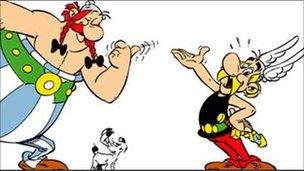Brain surgeons delve into world of Asterix and Obelix
- Published

The Asterix books abound with battles
If you want to know about life, read the Asterix books. If you want to know about death, read the Asterix books. And if you want to know about the bits in between - read the Asterix books. And maybe Donald Duck and the Pink Panther.
So think a team of very eminent brain surgeons in Germany.
They analysed different cases of biffing and bashing in the 34 volumes of the legendary comic book and compared them with the outcomes - symptoms like a tongue lolling out of an unconscious victim - and found they mirrored reality.
As they described the research task, in a learned medical journal which published the results: "The goal of the present study was to analyse the epidemiology and specific risk factors of traumatic brain injury [TBI] in the Asterix illustrated comic books."
It was, they added quickly in a demonstration of German humour, not entirely serious - but not entirely frivolous either.
Potion and helmet
"Sometimes I think we can learn that people before us had the same experiences so we should remember to analyse the past," said Dr Daniel Haenggi of the University of Duesseldorf.
But, the BBC pointed out, Asterix was not the past but a fictional representation of the past.
To which the author said that it was an exercise that reminded them of the importance of studying the past.
So what do we learn about brain injury in the world of Asterix the Gaul?
We learn that: "Although over half of patients had an initially severe impairment of consciousness after TBI, no permanent deficit could be found.
"Roman nationality, hypoglossal paresis, lost helmet and ingestion of the magic potion were significantly correlated with severe initial impairment of consciousness."
This last bit is important. It indicates that use of the magic potion softened the effects of a blunt instrument on a brain.
It also showed that the use of a helmet acted to soften the blow.
Lectin trail
A picture of trauma in Asterix emerges: "Among the 34 Asterix comic books analysed, 704 cases of head or brain injury were identified.
"The vast majority of victims suffered repeated traumatic injuries in one or more comic books. Nearly all head-injured characters were male (99.1%; 698 males, six females) and adult.
"Traumatic brain injury was caused by blunt force in 696 cases (98.8%), while strangulation occurred in eight cases (1.1%). In particular, most figures suffered from assault but few also from a fall."
The effect of the drug is double-edged: it gave the aggressor greater strength but the victim greater ability to survive the assault.
"Although the exact formulation remained secret, it is known that the magic potion contained mistletoe.
"The mistletoe component, lectin, has been shown to have effects on brain tumours, but the role in the treatment of TBI needs to be clarified by further studies".
Dr Karl Schaller, a Swiss colleague of the authors, said: "It would be interesting to compare the results from this comprehensive review of reported head injuries in all Asterix volumes with those of more recent heroes such as the Ducks or the Pink Panther and others, and to look at it with a possible trans-Atlantic perspective."